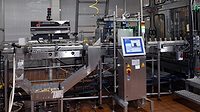TECH FLASH
Vision inspection sees what humans may miss
Increased packaging line speeds have made it more difficult for human inspectors to reliably remove nonconforming items.

Vision inspection is an essential part of any food processor’s safety program, as correct and readable packaging improves traceability and increases the information available to increasingly picky consumers. Consumers often look at “best before” dates and allergen content when making a product selection, and more comprehensive traceability can prevent some of the roughly 5,000 deaths estimated to occur from illness in the US each year.
A successful recall requires information including the producer’s name, product name or number, best before date and production date or lot number to be legible on the package. The globalization of food supply has complicated food manufacturing, as processors find themselves accommodating many location-specific labeling and packaging requirements.
Operator errors, packaging material defects and machinery failures can also lead to unsatisfactory packaging. Increased packaging line speeds have made it more difficult for human inspectors to reliably remove nonconforming items. According to a white paper from Mettler Toledo, “Vision Inspection: Now Vital for Food Safety,” vision systems can inspect products accurately at very high speeds, making them an important component of many producers’ food safety plans.
Food processors must take a number of legal regulations and directives into account, but generally those rules can be divided into two categories: information required to be on the packaging and processes required for the production of a specific food. Production lines are built with the first category in mind—specialized labeling and printing equipment exist to produce the specific food safety marking required by the government. The Federal Food, Drug and Cosmetic Act and the Nutrition Labeling and Education Act regulate label requirements in the US, while EU Regulation 1168/2011 governs requirements in Europe.
Markings including allergen contents, best before date, storage conditions and instructions for use are used for food safety; quantity, volume and weight are used for commercial purposes; nutrition facts, ingredients and amount of ingredients are used for nutritional purposes; and food producer name, production date and lot or batch number are used for traceability enhancement.
A vision inspection system is designed to ensure a production line always produces the required food safety markings on a given product. If a required marking is not present, the inspection system rejects the item to keep the processor compliant with food safety regulations.
Producers adopting a standard such as the Global Food Safety Initiative (GFSI) utilize a Hazard Analysis Critical Control Point (HACCP) method for food safety that can be monitored with vision inspection systems. HACCP can be seen as a prevention of hazards method rather than a finished product inspection method, but vision systems are still necessary in the monitoring processes of the GFSI standard.
GFSI standards specifically require labeling to conform to regulations and that it be “legible, indelible and shall comply with agreed customer product specifications.” However, with products on many processing lines moving at a rate of greater than one per second, a machine malfunction can mean hundreds of packages not meeting requirements within just a few minutes. According to Mettler Toledo’s white paper, using human inspectors to ensure all packages display required information would be extremely time consuming and prohibitively expensive. For best results, Mettler Toledo recommends the use of machinery with minimal failure rates combined with a vision inspection system.
The seven pieces of basic food safety information required on packaging are the best before date; production date, lot or batch number; allergen content; storage conditions; instructions for use; product name or number; and producer name and address. However, checking all seven markings can be complex and result in accidental rejection of conforming products. To alleviate these issues, manufacturers can pre-print information that is already known about the product before the packaging arrives at the manufacturing facility. This information includes allergen content, storage conditions, instructions for use, name or product number and producer name. Error rates for label printing companies are statistically insignificant enough that vision inspection may be foregone for these pieces of label information. The remaining information must be printed on labels at the time of production and packaging, as it is not known until the product has been produced. Weigh-price labeling and other exceptions do exist.
Vision inspection systems utilize either optical character recognition (OCR) or optical character verification (OCV). OCR attempts to verify the printed value regardless of imperfections or variations in the print while OCV tries to verify characters by comparing them to a saved master font. OCR is a more common choice in the food industry, where required information varies from product to product. Labels need not include certain print type or meet a particular standard to be acceptable. Of course, vision machines cannot replicate human reading exactly. One particular challenge is in reading markings made by printing techniques like continuous ink jet dot print.
Vision inspection can also contribute to ensuring seal integrity without contacting the packaging, which can slow down production lines. It’s important to note that vision inspection methods can only check the outside characteristics of a seal, not the actual integrity which requires physically compressing a package and measuring air or content loss. Vision systems can inspect packages for indentations cause by vacuum sealing, integrity of plastic caps and lids, and the continuous indentations caused by some sealing processes.
According to Mettler Toledo, vision inspection can provide substantial cost savings and brand protection by limiting recalls and reducing time before nonconforming products are fixed.
For more information, visit www.mt.com/ci-vision.
Looking for a reprint of this article?
From high-res PDFs to custom plaques, order your copy today!








